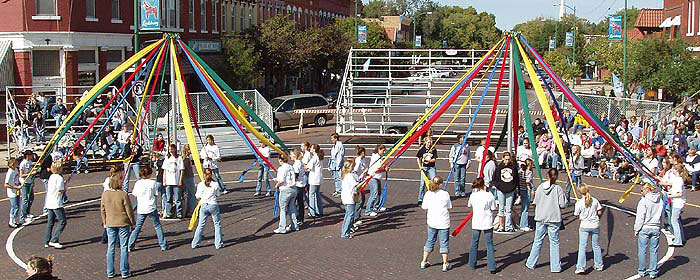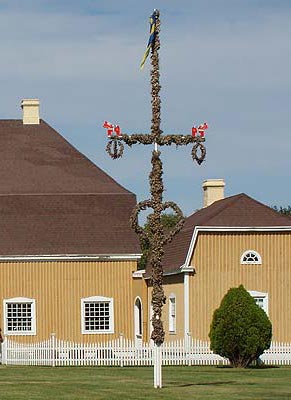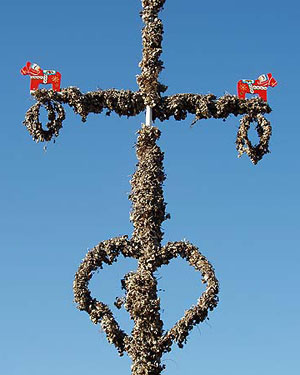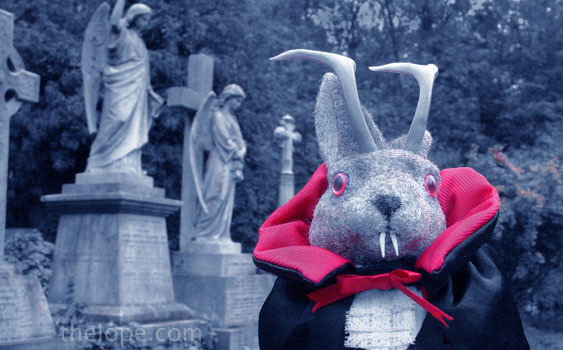Nosferatu to Primavera
You can bring in the garlic now.

Today is May Day - the first day of May. Yesterday, to prepare for this, we went shopping the local greenhouses looking for Lily of the Valley, a flower traditionally sold and worn in France on May 1. I've always had a thing for May Day; it's one of the things the French do so right. We didn't find any Lily of the Valley that was blooming, but if we do in the next few days, I'll add a picture here.
May Day was the traditional summer holiday in many pre-Christian cultures. In fact, the reason midsummer's day is "midsummer's" day is that they'd already started to refer to the time of year as "summer" (or whatever their word was) on May 1 so the summer solstice was at about the middle of their definition of "summer." I like that better than the modern system...seems more logical
Traditional Roman Catholicism referred to summer as "Mary's Month" and the Lily of the Valley became symbolic of Mary's tears.
When I asked my neighbor if she had any Lily of the Valley blooming, she told me of the tradition of giving May baskets, which she remembered as a little girl in the Midwest. May baskets were baskets of flowers - real or craft-made - which were left, usually anonymously, on the porches of friends, neighbors or strangers. It sounds like a charming custom; it's too bad it has faded away.

Today in the USA, May 1 is the rather vestigial holiday, Loyalty Day, used to re-affirm loyalty to the USA and its principles. The holiday is legal, but not federal, so you don't get time off to do this; I suppose we'll just have to re-affirm in whatever way the Patriot Act dictates. Loyalty Day started out in 1921 as "Americanization Day" and was intended to counterbalance Labor Day, which many saw as communist. Fun story, isn't it, considering that we now regard Labor Day as about all-American as it gets? I guess that Loyalty Day is sort of "Independence Day lite". I want fireworks; we should get to blow stuff up at least twice a year.

As to older May Day practices, The maypole is one of those delightful left-overs from Germanic paganism that survives to the present day. Here, young people in the Swedish-themed town of Lindsborg, KS practice a maypole dance for their October Svensk Hyllninfest in 2005. Although this was a Fall festival, and maypoles are traditionally used more at midsummer in Sweden, there are also traditions in Europe which involve maypole dances on May Day. Like almost anything else that is fun, maypoles have been occasional victims of evangelical Protestants over the centuries; they didn't like mixed-gender dancing.

Here's an ornate maypole at Lindsborg's McPherson County Old Mill Museum.

And here's a closer view of the top. Maypoles were often a source of civic pride, and had to be protected from raids carried out by neighboring villages. This was usually only as serious as a modern college stealing another college's mascot, but was occasionally more serious, as in England's Hertfordshire in 1602 and Warwickshire in 1639, when such pole theft incidents were a catalyst to violence.
Maypole dances are the most apparent post-Christianization traces of the earliest European May Day celebrations, such as the Celtic celebration of Beltane, and the Germanic Walpurgis Night, which is the night before the dawn of May 1.

Fans of Bram Stoker's Dracula may remember that the events of the 1931 film began on Walpurgis Night. This was appropriate, since the events of Stoker's short story, "Dracula's Guest", which is actually the deleted first chapter of "Dracula", took place that night.

Stoker: "Walpurgis Night was when, according to the belief of millions of people, the devil was abroad – when the graves were opened and the dead came forth and walked. When all evil things of earth and air and water held revel."
Wasn't that a ray of May sunshine? Actually, it's a rainy night here in Kansas, with a bit of a chill in the air; the sun never really rose today. We're suspended between Nosferatu and Primavera - the darkness of Walpurgis Night and the light of Spring.
Sweet dreams and, uh, Happy May Day.

Today is May Day - the first day of May. Yesterday, to prepare for this, we went shopping the local greenhouses looking for Lily of the Valley, a flower traditionally sold and worn in France on May 1. I've always had a thing for May Day; it's one of the things the French do so right. We didn't find any Lily of the Valley that was blooming, but if we do in the next few days, I'll add a picture here.
May Day was the traditional summer holiday in many pre-Christian cultures. In fact, the reason midsummer's day is "midsummer's" day is that they'd already started to refer to the time of year as "summer" (or whatever their word was) on May 1 so the summer solstice was at about the middle of their definition of "summer." I like that better than the modern system...seems more logical
Traditional Roman Catholicism referred to summer as "Mary's Month" and the Lily of the Valley became symbolic of Mary's tears.
When I asked my neighbor if she had any Lily of the Valley blooming, she told me of the tradition of giving May baskets, which she remembered as a little girl in the Midwest. May baskets were baskets of flowers - real or craft-made - which were left, usually anonymously, on the porches of friends, neighbors or strangers. It sounds like a charming custom; it's too bad it has faded away.

Today in the USA, May 1 is the rather vestigial holiday, Loyalty Day, used to re-affirm loyalty to the USA and its principles. The holiday is legal, but not federal, so you don't get time off to do this; I suppose we'll just have to re-affirm in whatever way the Patriot Act dictates. Loyalty Day started out in 1921 as "Americanization Day" and was intended to counterbalance Labor Day, which many saw as communist. Fun story, isn't it, considering that we now regard Labor Day as about all-American as it gets? I guess that Loyalty Day is sort of "Independence Day lite". I want fireworks; we should get to blow stuff up at least twice a year.

As to older May Day practices, The maypole is one of those delightful left-overs from Germanic paganism that survives to the present day. Here, young people in the Swedish-themed town of Lindsborg, KS practice a maypole dance for their October Svensk Hyllninfest in 2005. Although this was a Fall festival, and maypoles are traditionally used more at midsummer in Sweden, there are also traditions in Europe which involve maypole dances on May Day. Like almost anything else that is fun, maypoles have been occasional victims of evangelical Protestants over the centuries; they didn't like mixed-gender dancing.

Here's an ornate maypole at Lindsborg's McPherson County Old Mill Museum.

And here's a closer view of the top. Maypoles were often a source of civic pride, and had to be protected from raids carried out by neighboring villages. This was usually only as serious as a modern college stealing another college's mascot, but was occasionally more serious, as in England's Hertfordshire in 1602 and Warwickshire in 1639, when such pole theft incidents were a catalyst to violence.
Maypole dances are the most apparent post-Christianization traces of the earliest European May Day celebrations, such as the Celtic celebration of Beltane, and the Germanic Walpurgis Night, which is the night before the dawn of May 1.

Fans of Bram Stoker's Dracula may remember that the events of the 1931 film began on Walpurgis Night. This was appropriate, since the events of Stoker's short story, "Dracula's Guest", which is actually the deleted first chapter of "Dracula", took place that night.

Stoker: "Walpurgis Night was when, according to the belief of millions of people, the devil was abroad – when the graves were opened and the dead came forth and walked. When all evil things of earth and air and water held revel."
Wasn't that a ray of May sunshine? Actually, it's a rainy night here in Kansas, with a bit of a chill in the air; the sun never really rose today. We're suspended between Nosferatu and Primavera - the darkness of Walpurgis Night and the light of Spring.
Sweet dreams and, uh, Happy May Day.


2 Comments:
As of Wed., May 2nd Richard was still the oldest soda jerk - and still working at Hunter's Drug. KSN had a feature story on him on their "Positively Kansas" segment. Who would have thought that two days later, such devastation would occur. Here's the link to the KSN feature from May 2nd: http://www.ksn.com/news/local/7301591.html
Great Blog - So nice someone was able to document that slice of life at Greensburg.
Post a Comment
<< Home